Day 1 of a three day tour today, focusing on the Brecks and some of our lingering winter visitors on the coast. It was a rather grey and cloudy day, but dry and fairly still. We decided to try our luck down in the Brecks.
It was not an ideal morning for the Lesser Spotted Woodpeckers to be out drumming, a bit cool and overcast, and after the long drive down to the Brecks we had missed the early morning peak in activity, but they have been very active displaying in the last week or so we figured it was worth a good go. As we got out of the van, a Greenfinch was trilling and wheezing from the top of the nearby birch trees, and a Grey Wagtail circled round over the car park singing too – a good sign that birds were still displaying despite the cooler weather today.
Walking down the road towards the bridge, we could see lots of finches in the garden of the house with the feeders and a female Brambling perched up nicely in a tree in the hedge.
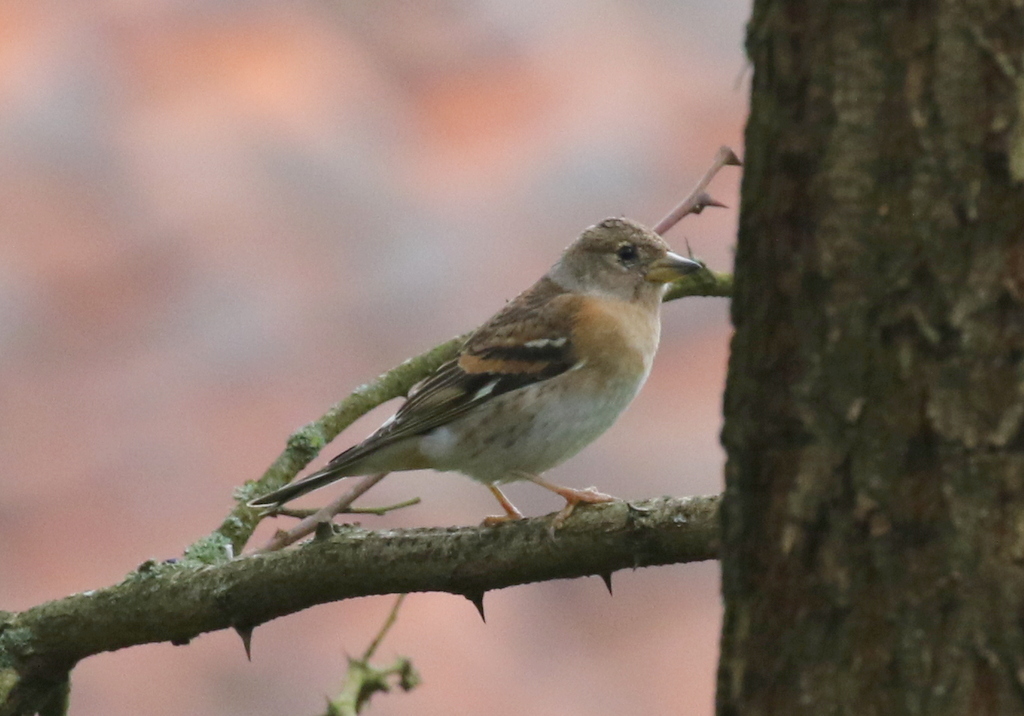
There were lots of Siskins singing in the alder trees by the river and flying back and forth overhead in little groups. We flushed several birds from the bushes ahead of us as we walked down the path – Brambling, Redwing, Reed Bunting. We heard a Mandarin call in the trees, but couldn’t see it.
A Great Spotted Woodpecker was drumming off in the distance, perhaps another good sign, and a second bird then called a bit closer. We could hear a Woodlark singing off in the distance too – one to look for on our way back. For now, we were focused on trying to find the Lesser Spotted Woodpeckers.
We stopped at a block of poplars by the river, where we have seen the woodpeckers regularly in recent days. Apparently a Lesser Spotted Woodpecker had been seen much earlier further up along the river, but someone else thought they had heard one closer to here, so we decided to try our luck in this spot.
There was no sign of the woodpeckers at first, but they are so small and can disappeared back into the thicker birches at the back or over the river into the alders for long periods. there were lots of finches and tits feeding in the tops of the trees. A Nuthatch was feeding up in the poplars too.
Then we heard the distinctive, sharp ‘kee-kee-kee’ call of a Lesser Spotted Woodpecker. We scanned trees the tops of the poplars and after a couple of minutes we spotted the female Lesser Spotted Woodpecker fly across and land on a small branch high in the canopy. We got it in the scope, and watched as it climbed up one thin stem, looking for food, then flicked across to the next one and did the same thing again.
It tried several different branches, occasionally stopping to pick at the bark, and then when it dropped across to the next one, the male Lesser Spotted Woodpecker suddenly appeared next to it. You could just make out its red crown. The female flew and the male chased after it, pursuing it from branch to branch – part of their courtship display. Then the two of them stopped high in the tree, perched on a branch, the female above and the male just below.

We got the scope on the pair of Lesser Spotted Woodpeckers again and while the group stopped to watch them, a quick dash up the footpath was required to shout for some other local birders who had walked further on to check out the block at the far end. By the time we got back, the woodpeckers had disappeared into the trees again, but at least we knew where they were now.
As we stood and scanned the trees for a few minutes, someone picked one of the Lesser Spotted Woodpeckers again, lower down on the trunk of a tree further back, just the female this time. We watched her climbing up through the branches, before she flew across and was lost to view.
Listening carefully, we could hear quiet tapping coming from roughly the area where the female Lesser Spotted Woodpecker had flown, but after staring hard at the trees, someone eventually found a Great Spotted Woodpecker, low down on the trunk of an alder tree. We got the scope on it, and could see it was much larger than the Lesser Spotted Woodpeckers we had just been watching. It had a block of red on the back of its head, indicating it was a male. The female Great Spotted Woodpecker then appeared on a tree nearby.

At least one Lesser Spotted Woodpecker was still close by as we heard it call a couple of times, a bit further back in the trees. After scanning the tops carefully, we eventually found it again when it appeared in the top of another poplar. It was the female again and we watched it feeding once more, right up in the small branches high in the canopy. At one point it stopped, hammering on a small twig for a couple of minutes, clearly having detected some food. We were treated to some really prolonged views this time, about fifteen minutes – a real treat, for this somewhat elusive species – as it moved between the branches of the poplars.
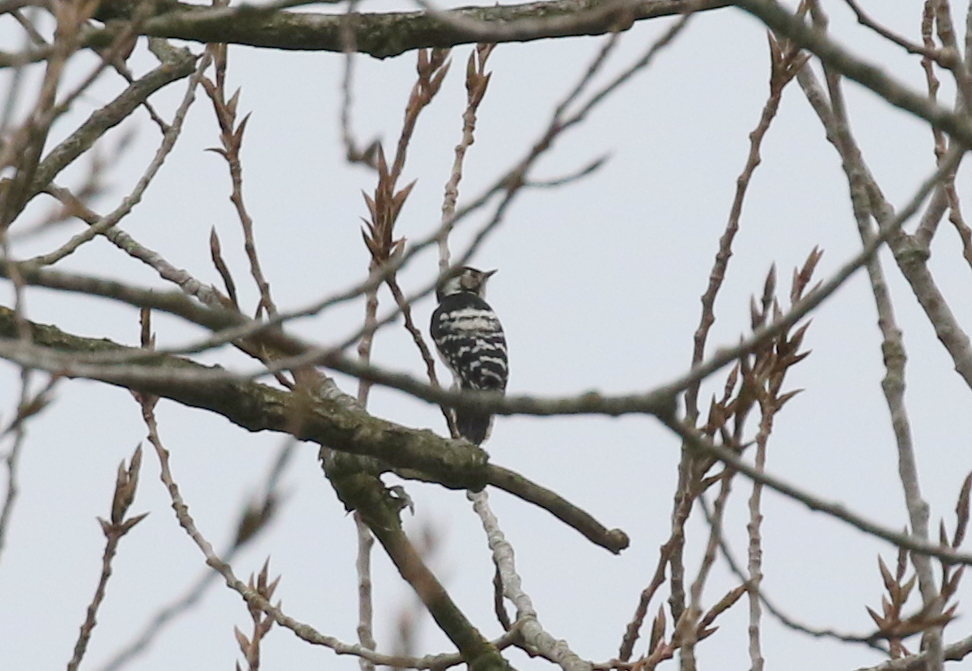
Finally the Lesser Spotted Woodpecker flew across and disappeared into the denser block of trees over by the river, so we decided to move on. On our way back, we cut across towards the area where we had heard the Woodlark singing earlier.
There were lots of finches in the trees by the reedbed, mainly Chaffinches and Bramblings, but we could hear one or two Redpolls calling too. It appeared they were coming down to drink and bathe in the water below the trees. Once they were finished, they flew back up into the tops before flying across the path and back to the pines beyond. Most of them didn’t sit still for long, but we eventually got the scope on some smart male Bramblings.
As we reached the railway underpass, we heard a Woodlark call and turned to see it drop down on other side of railway. Through the underpass, we quickly found a Woodlark in the short heather and grass in the clearing beyond. We got it in the scope, and as it started to walk across, picking around in the vegetation, we could see another Woodlark next to it, and then a third.
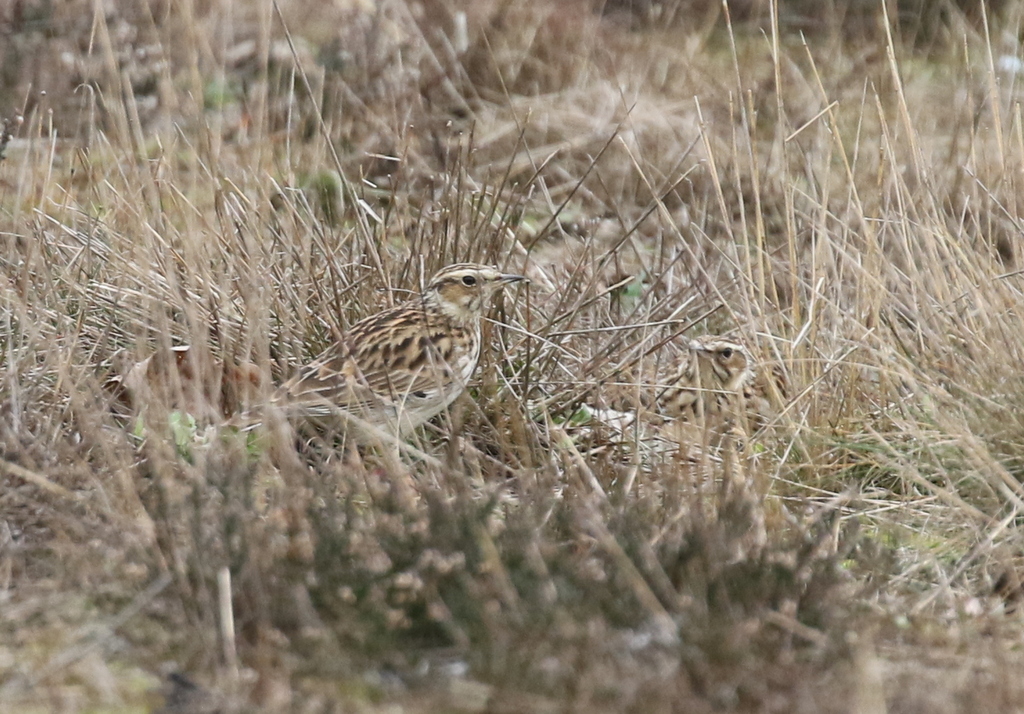
Two of the Woodlarks then started fighting, fluttering at each other, rising about a foot off the ground before landing again, presumably two males arguing over territory or the female. They parted and seemed to resume feeding, before coming back together several time. Eventually, the pair walked off together one way, over towards the longer grass, the male singing softly. The other male walked away in the other direction, further down the clearing, feeding.

While we were watching the Woodlarks, we heard Carrion Crows cawing loudly behind us over the pines and turned to see low of Woodpigeons scattering from the trees. There had to be a Goshawk somewhere to cause such a commotion and after a couple of seconds one appeared above the treeline. A couple of crows chased after it briefly, giving us a good size comparison, and we watched as the Goshawk flew off away from us, turned over the railway, and then headed off over the river.
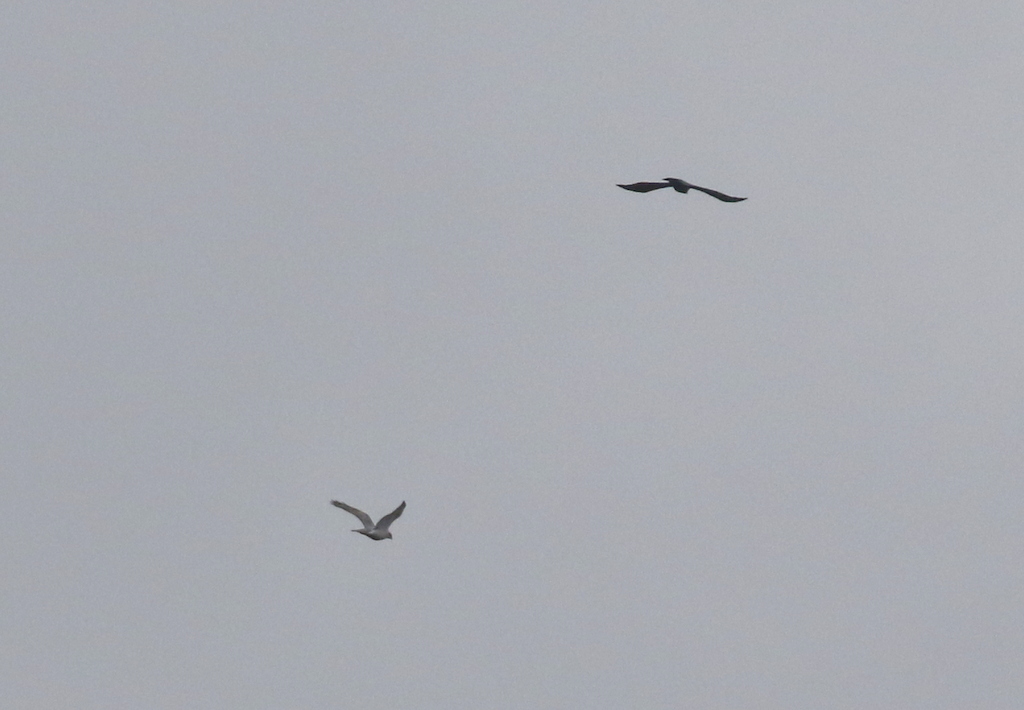
There were a few more birds to see as we made our way back to the car. We finally managed to find one of the redpolls in the top of the trees, a smart male Lesser Redpoll with bright pinky-red breast, which we got in the scope. A pair of Marsh Tits appeared on the edge of the pines, and flew over our heads down towards the railway. Back at the bridge, we found a Redwing feeding with Blackbirds in some dense ivy. And we finally got some nice views of Siskins on the feeders.
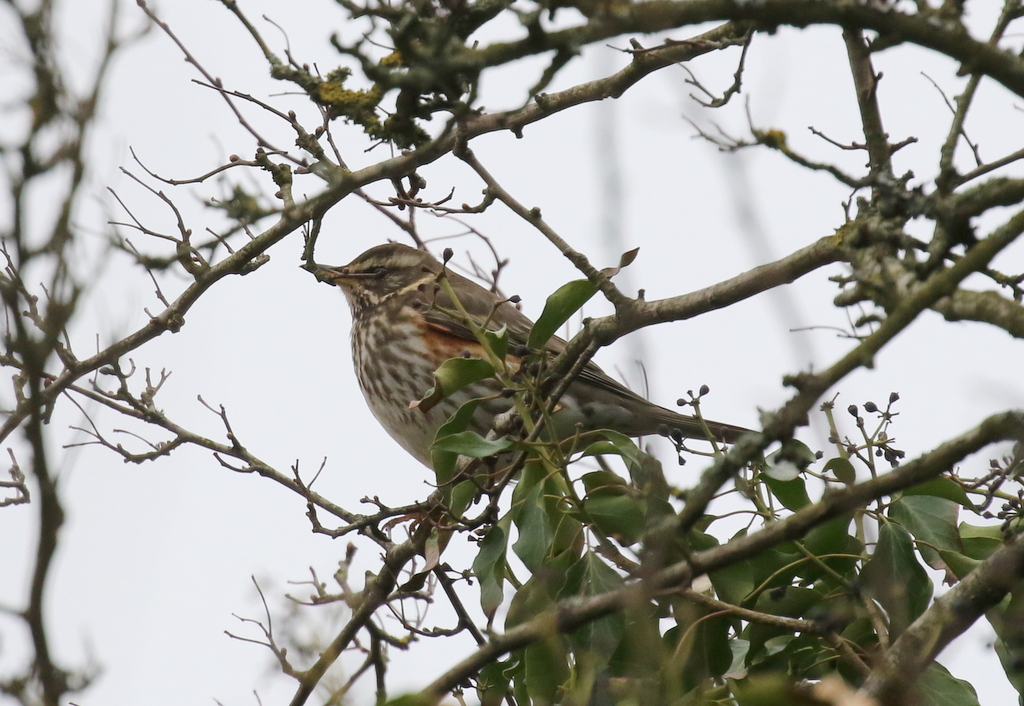
It had been a very productive morning here and when we got back to the van, it was already time for lunch, so we headed over to Brandon to get a hot drink and use the facilities. After lunch, we made our way down to the small lake. There are often some rather tame Mandarins here, and we were not disappointed today. We counted twelve of them, nine very smart males and three females.
They were roosting out on the grass under the trees with the local Mallards. What at first glance appeared to be a Shoveler with them turned out to be a Shoveler x Blue-winged Teal hybrid – its bluish head with a diffuse white crescent marking and dusky patterned white underparts betraying its mixed parentage. The drake Mandarins started displaying, lifting their necks and raising their ornate crests – amazing looking birds!
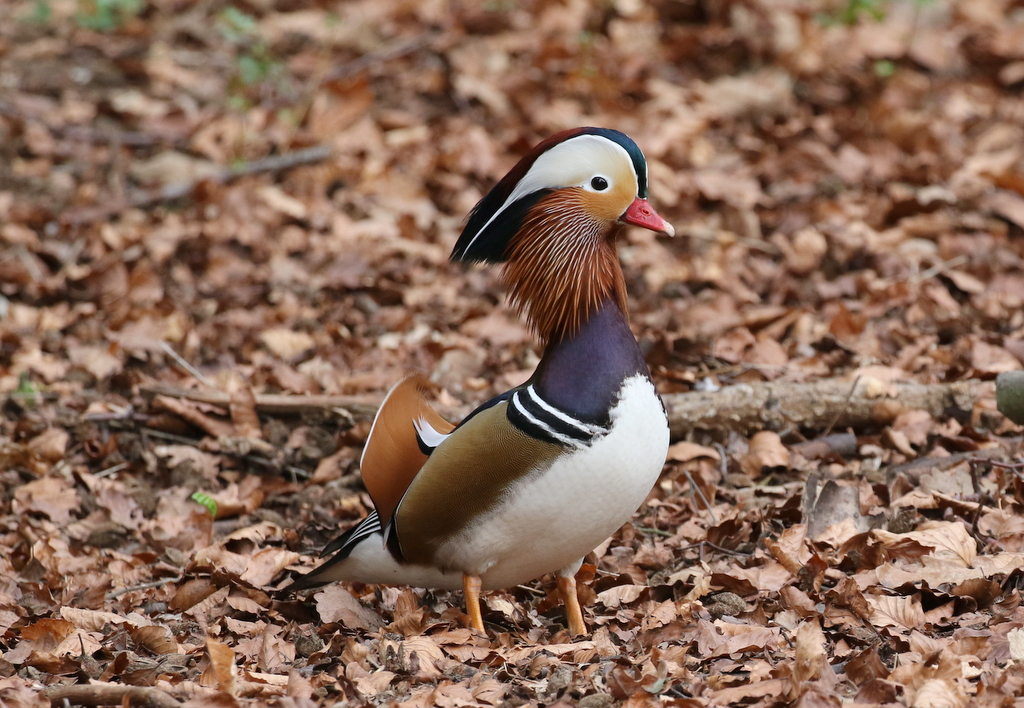
As we walked around the lake, we first heard a Goldcrest singing and then a sharper call from the fir trees in the corner alerted us to a Firecrest overhead. We watched it flicking around in the branches on the edge of a tall fir tree, where we could see its bold face pattern with obvious white supercilium and black eyestripe. Eventually it worked its way up and disappeared into the thicker branches towards the top.
There were also a couple of Marsh Tits and a Nuthatch in the trees here. As we made our way back to the car park, we stopped to listen to a Treecreeper call, which then helpfully flew in and landed in one of the trees next to us, where we could see it climbing up the trunk. At least, when it didn’t do its usual trick of disappearing round the far side of the tree!
We made our way further south into the Forest and stopped by one of the rides. As we walked in past a small clearing, we could hear a Woodlark call but we couldn’t see it. Two small birds flew up from the edge of the trees, but rather than the Woodlarks they were two smart male Yellowhammers. They disappeared into the edge of the pines at first, where they were hard to see, but one eventually flew out and landed in a small bare birch tree in the middle of the clearing. After we had all had a good look at it through the scope, the second flew out of the pines too.
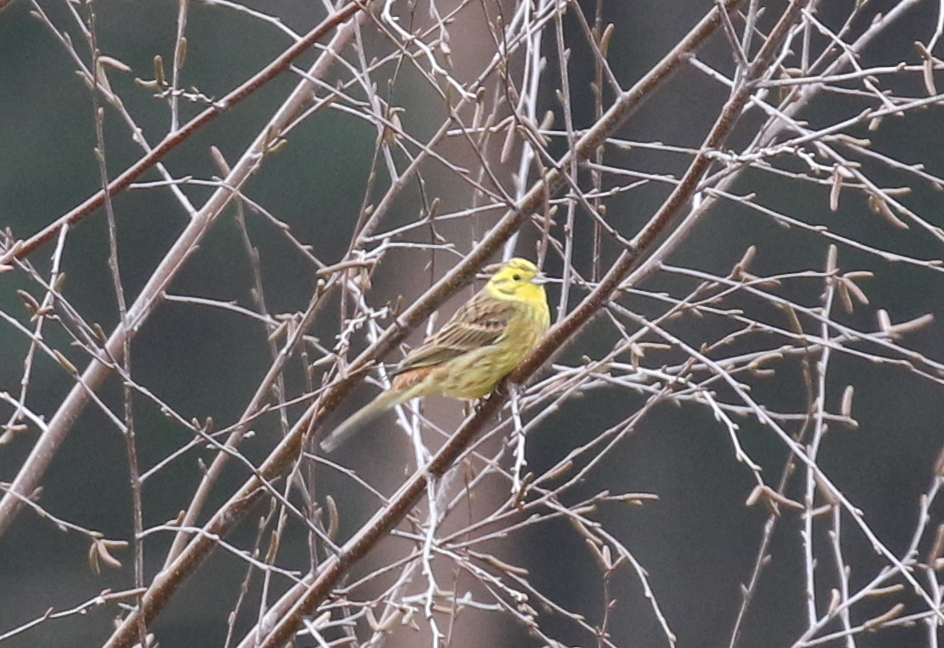
Further on along the ride, we could hear loads of finches twittering in the tops of a line of deciduous trees flanking the path. We looked up to see lots of Chaffinches and Bramblings. We got a male Brambling in the scope, and back on we could see the distinctive white stripe down its back. There were Siskins and at least a couple of Lesser Redpoll too.
The finches were flying backwards and forwards across the ride into the pines opposite. They were most likely looking for seeds. In the warmer weather over the last week or so, the pine cones started to open, revealing a bonanza of seeds. Whereas the cones are normally closed, and the seeds can only be accessed by specialist feeders like Crossbills, when they open in the spring the seeds are suddenly freely available to all. Further on along the ride, as if on cue, a Crossbill flew low overhead calling.
As soon as we got in to the clearing at the far end, we could see the Great Grey Shrike out in the middle. Perched up on the top of a small pine sapling, its pale silvery grey and white plumage meant it really stood out. We walked on over to the fence on the edge of the plantation, from where we got a good view of the Great Grey Shrike through the scope.
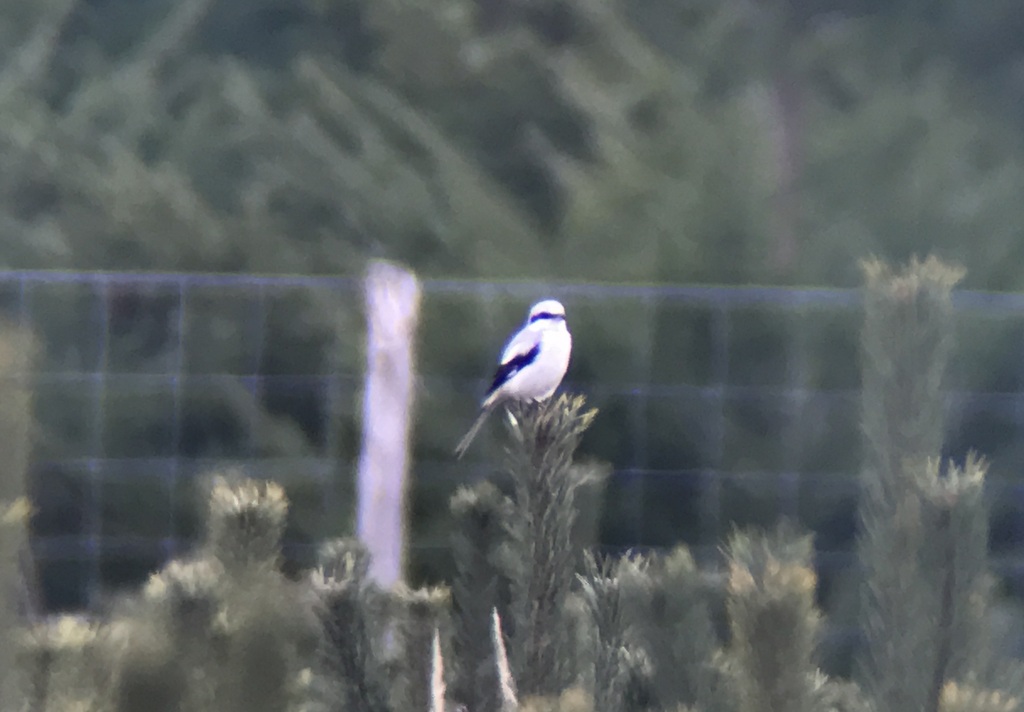
For a long time, the Great Grey Shrike helpfully remained where it was, on the same small pine tree, so everyone could get a good look at it. Got Then after a while it started to get more active. It dropped down out of view, then flew across to another tree. It did this several times, working its way slowly back through the plantation, before we lost sight of it.
It was a nice way to end a very successful first day in the Brecks, watching the Great Grey Shrike. On the walk back, several more Crossbills flew over calling, but didn’t seem to stop. They would be very hard to see anyway in the dense mature pine plantations – one for tomorrow. For now, it was time to call it a day and head for home.
















